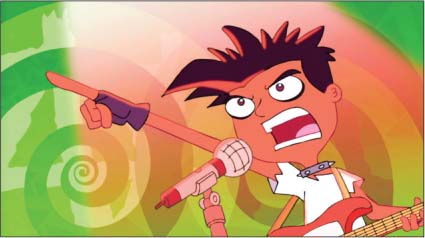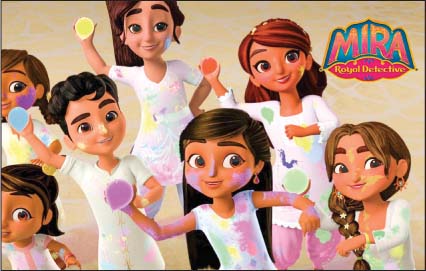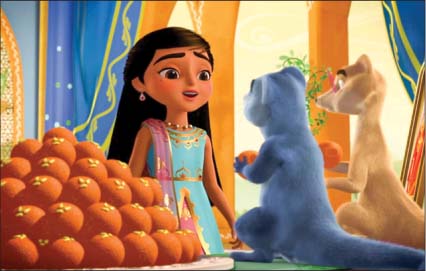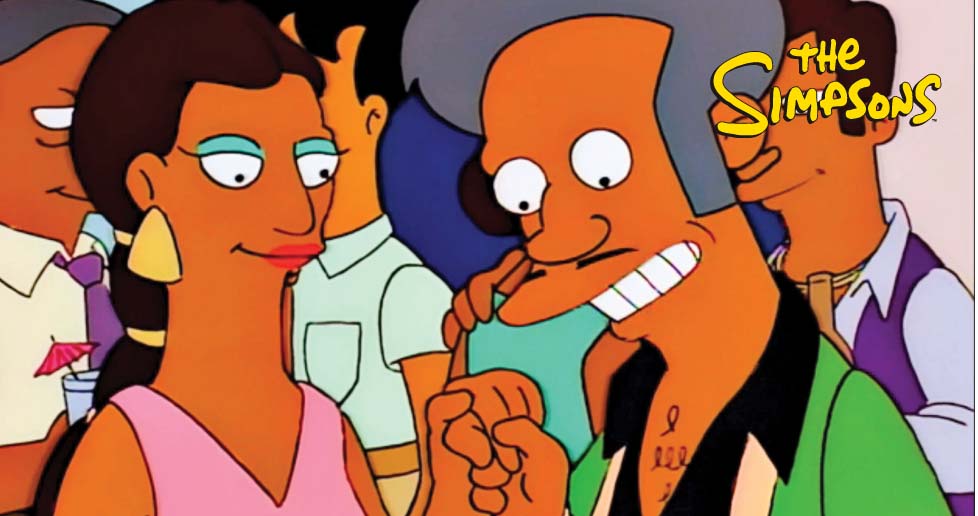They may just be fictional shows, but the often-stereotyped
depictions of Indian characters on TV have a real-life impact
By Rutvij Holay

For many of the indian community raised in the united states, including myself, it is a rite of passage to see our religion depicted in TV shows and movies. For most of us, this is the first impression of how the average American seems to view our way of life. Depending on the show, we’re depicted as money-grubbing store owners, nerds with no social life or devout pagans following exotic Gods and traditions.
Some of us ignore these stereotypes, some act like the stereotypical characters, and some shun our culture altogether. Given the influence that these shows can have on us, it is essential that we understand them and their influence, so that we may educate ourselves accordingly. To do so, I propose to group their representation of Hindus and Hinduism into three eras: the Apu era, the Ravi era and the Mira era.
The Apu Era: 1989
The Apu era, named after Apu Nahasapeemapetilon from The Simpsons cartoon, is well known among those above 30, and may be the most publicized example of Indian representation on a TV show. None of the producers, writers or voice actors is Indian. Apu, with the exotic, long last name (which doesn’t follow any known Hindu naming practice), is portrayed as a devout, hardworking Hindu who runs a Kwik-e-Mart convenience store. From this characterization, the stereotypes flow freely. The workaholic (“I work 22 hours a day”) who just nearly missed work because he was shot, is clearly derived from the “model minority” myth, the idea that all Hindus, and Asians in general, are naturally more hardworking than all others.
Apu is portrayed as a Hindu vegan devoted to Ganesha, and a believer in reincarnation and karma. In part, this all sets the stage to use stereotypes about Indian culture as plot devices, such as in season 7, episode 22, when Apu goes to a party. After eating some tofu hot dogs, he sees a girl with no ring on her finger, and says, “Ah! No ring, I see, so you are only arranged to be married.” A few moments later, after dancing with her, to quell rumors of any pending affair, he promised that he would tell everyone she was “untouchable.” Through this scene, creators of the show implied that caste, and Untouchability along with it, exists in the United States. This serves to solidify the myth of the wider caste pyramid, often used by missionaries to target certain Indian groups for conversion, and defame Hinduism in the process.
Furthermore, anyone who has firsthand experience with the Indian system of marriage understands that arranged marriages aren’t an oppressive tradition where the girl is destined to be married to a certain man at birth. Rather, the girl can say no to a match, and even choose her own husband, as long as the rest of the family approves. There’s an entire episode in season eight devoted to Apu’s arranged marriage with a girl he hasn’t seen in twenty years. He first tries to escape, but then upon meeting the girl, falls in love with her and proceeds to have eight children.
Even though the show is inconsistent in its references to Hindu customs—even the same custom, as we saw with marriage—and even though Indians understand this is a cartoon exaggeration, many of their non-Indian and non-Hindu counterparts may not. In fact, I’ve heard a middle-aged teacher claim to students that Hindus “have a caste system that is so bad you just have to get out.” I have no doubt that, for her and many others, shows like The Simpsons played a role in their ignorance. People who influence millions, and who are expected to be far more educated, have also made such claims. For example, President Joe Biden joked that “You cannot go to a 7-11 or a Dunkin’ Donuts unless you have a slight Indian accent,” a quip that may have very well been inspired by Apu and his Kwik-e-Mart.
The Ravi Era: 2007-2015


Many people my age grew up with the TV sitcom Jessie, with its Indian-American character Ravi, one of several adopted children under the care of nanny Jessie. By this time, and in contrast to Apu, representation of Hindus was broadening in both the number of shows in which Hindus appeared and the age groups targeted, so other notable characters emerged as well, such as Baljeet from the Phineas and Ferb cartoon.
As more Indians moved into the IT sector, began to win the spelling bees (every national one from 2008 to 2019), and achieved much more in the US, a common theme emerged in their representation: Every single one of the characters in these shows was a nerd. They did very well in school, especially in math and science, and had little to no social life or athletic ability.
One of the first representations of this stereotype was Baljeet. In season two, episode 14, he signs up for a “Summer Rock” class, assuming it is about geology, before learning it is about rock and roll. This makes him so mad he spends the class doing math. In the end, as he performs a rock song, he yells out the lyrics, “Somebody give me a grade—and make it an A.”
The representation of Apu was universally panned as negative, especially in Hari Kondabolu’s documentary, The Problem with Apu. Having all Indians as nerds in the Ravi era is, in my opinion, a two-edged sword. On the one hand, this is in many ways a positive stereotype, something that people admire about our community, and I can’t imagine many who mind being called intelligent. Such stereotypes inspire our people to be better, to get better grades. From personal experience, I can certainly tell you that it helped my test scores.
On the other hand, try as they might, there are students in our community who cannot earn such grades. They may feel inferior, since all Indians are meant to be smart—at least according to these shows. I’ve heard fellow students say, “I’m Indian; of course I’m in all honors,” or something similar. Such stereotypes, especially since they are embraced by our own community, have been known to cause mental health problems, making this an important issue.
At the same time, it may lead to resentment from other communities, who feel that we are unfairly better off. This leads to discrimination both from individuals, and through systemic programs such as racial preferences which favor non-Asians over Asians in college admissions in the United States.
In terms of religion, I found the coverage of Hinduism in this era far more confusing. In Phineas and Ferb, Baljeet doesn’t talk about Hindu culture much—which is a problem in and of itself—but Ravi does make extensive mention of it. Perhaps the most interesting incident would be in season one, episode three, which focuses on karma. In it, Ravi’s adopted brother Luke plays a prank on him, and to get revenge, Ravi devises an elaborate plot revolving around karma. He warns Luke of “cosmic payback,” in the form of karma, and sets up a series of pranks to make Luke believe that karma is real, then makes him stand outside in the rain as a sort of penance.
This idea of karma as some form of “cosmic payback” has always been a flawed understanding of karma in the American mainstream. Rather, karma is better understood as an extension of Newton’s Third Law of Motion. However, rather than governing mundane actions such as throwing a ball in the air, karma also extends to moral and immoral actions.


Towards the end, Ravi’s nanny Jessie learns about the plot and makes Ravi admit that he set up the pranks on his own and they were not some superstitious “cosmic payback.” One wonders what would happen if a similar incident occurred with a central principal of Islam or Christianity—for example, if Jessie made some Rehman or Robert admit that Allah or Jesus wasn’t real. I can imagine that, rightfully so, there would be far more backlash, and the producer of the show, Disney, would be forced to apologize.
Since this show was written seven years ago, much has happened in the US in terms of “political correctness” which has changed the way stereotypes about minority cultures, including Hinduism, are presented in the media, for better and worse. At the same time, during these seven years, in my experience, there has been a distinct rise in hostility towards Hindus and Hinduism for various reasons.
The Mira Era: 2020
It is perhaps in an attempt at political correctness that the current generation is growing up watching shows remarkable for their increased accuracy and lack of stereotypes. In the kids’ cartoon show Mira, Royal Detective, for example, the characters have Indic names, play sitars and tablas, and celebrate Indian festivals. Compared to Apu, who listened to Middle Eastern music portrayed as “Indian” and celebrated a far more intentional mockery of Indian festivals, it is a wonder how far we have come.
Unfortunately, the show’s producers have done this is by sidelining Hinduism altogether. In season one, episode 19, on Diwali, there is extensive portrayal of rangoli decorations, divya lamp and other aspects of how the holiday is celebrated. Then at one point, Mira mentions that Diwali isn’t Diwali without ladoos—and her pet mongooses devouring the sweets becomes a recurring motif in the show. But there is not a single mention of Shri Ram and His triumphant return to Ayodhya or any of the other traditions associated with Diwali across India. Delicious as ladoos may be, there’s no doubt that one can honor Diwali without them; yet few Hindus would do observe the festival without Shri Ram, Goddess Lakshmi, or one of the many other Deities worshiped this day.
This treatment isn’t limited to Diwali. Season one, episode 25, features the spring Holi festival, but there is no mention of the downfall of the demon Holika or of Krishna and Radha. Instead, the episode features a Bollywood-style dance and a parade in which the main activity is the tossing of colors. This includes a dodgeball-like game involving water balloons, something that isn’t even done in India.


Conclusion
All this reminds me of a saying in a Sanskrit textbook of mine: “Without the Vedas, Gitas and Ramayana, and without the poems of Kalidas, India is not India.” When examining the representation of Hindus in the media in its entirety, then, it is important to acknowledge that older shows such as the Simpsons and Jessie attacked our Vedas, Gitas and Ramayana no doubt, but it should be noted that they did keep them. In that sense, it was a heavily flawed representation of our culture, but it was Indian culture nonetheless.
Mira and shows like it, to their credit, don’t bash any of our religious beliefs, but that’s only because they aren’t there at all. They’ve taken away the philosophy and stories of the Vedas, Gita and Ramayana, and in doing so, there is a strong argument that they’ve taken away Indian culture itself. That they do it to appeal to Western tastes is only more hypocritical, given the emphasis that Disney and other television channels have placed on understanding other cultures.
I’ve talked with many community members on this issue. Some have said they prefer that producers not talk about Hindu culture at all, if the only way they can do so is by attacking it. Others have argued that showing India without Hinduism is just as insulting, if not worse. To me, the question we need to think about is: in public would we as a community prefer a culture that is attacked, or one that is nonexistent?
Rutvij Holay, 15, of Irvine, California, an executive-committee member of Americans for Equality PAC and a budding Hindu political activist, is presently working with his local school district and a textbook company to change how Hinduism is depicted in education. He can be reached at rutvij.holay@gmail.com.

This was a beautiful expose on the complicated nature of our relationship and portrayal in the American media landscape. You’ve done a laudible job of taking us through the various eras. I’ve had a hard time contextualising WHY this era of mira 2020 is so troubling.
I think I’d rather be attacked than erased.
The issue is that they do both at the same time. They erase our connection to Hindu things like Yoga and Meditation and mindfulness and then they turn around and attack us for casteism and our gods and our vedas/upanishads. As if we are uniquely responsible for every evil on this planet. Disheartening to say the least. But I am glad other young Hindus are talking about it! It means we have hope if our eyes are open!!